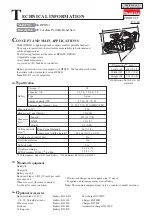
EN
7
machine
• Push the button in the handgrip to unlock the
saw blade protection
• Push the machine completely downwards
• Lock the pin on the right hand side again
Only lift the machine by the solid underside of the
machine.
While the machine is in use
With frequent use of the machine, do not let
routine lead to mistakes. Remember that a slight
lack of concentration can lead to serious injuries
in a fraction of a second.
• Before beginning to saw, make sure that the
protective hood is in the right position.
• Before cutting the first cut, let the machine run
for a short while. If you hear any unusual
sounds or observe any strong vibration, turn
the machine off and take the plug out of the
socket, and then find the cause of the
problem. Do not switch the machine on again
until the cause has been found and the fault
repaired.
• Make sure that the piece of work being sawn
off does not get stuck in place, do not hold it or
clamp it and no not secure it against the stop.
It must be able to move freely along the side
of the saw blade. When this is not possible the
piece of work being sawn can be trapped by
the saw blade and be flung about.
• Avoid placing your hands anywhere where in
the case of a sudden movement one or both
hands can come into contact with the saw
blade.
• Let the saw get up to full revolutions before
you start sawing.
• Press the saw head downwards so that the
motor is not overloaded and the saw blade
does not get jammed.
• If you need to remove jammed material, first
let the saw blade stop turning completely,
switch the motor off and take the plug out of
the socket.
• At the end of the sawing process, keep the
saw head downwards, switch off the machine
and wait until all moving parts has come to a
stop before you take your hands off the
machine.
Motor
• Connect the machine to a 220/230 Volt
socket.
• If the motor does not start, immediately
release the switch. Take the plug out of the
socket. Check that the saw blade can turn
freely. If so, try starting the machine again.
To prevent damaging the motor must be
regularly freed of chips and dust to
ensure correct cooling.
• If the motor suddenly stops while sawing, let
go of the switch immediately. Loosen the saw
blade from the piece of work, after which
sawing can continue.
• Using long cables of too small a diameter can
result in loss of voltage, which can lead to
problems with the motor.
• For a length up to 15 metres a cable must be
used with a diameter of 1.5 mm
2
.
• For a length of between 15 and 40 metres a
cable must be used with a diameter of 2.5
mm
2
.
3. Assembly and accessories
Installation of the mitre saw
Figs. 1 and 2
• Place one extension piece (21) on the right-
hand side of the machine and the other
extension piece (21) on the left-hand side of
the machine.
• Loosen the locking bolts (23) and slide the
guide rods in the openings.
• Tighten the locking bolts again (23).
• Place the work piece clamp (7) on the left or
right side of the machine.
• Hold the handgrip and move the saw slightly
downwards and then pull the pin (5) out
slightly so that the machine comes free.
Note: Never use the mitre saw without the
extension pieces supplied. Make sure that they
are correctly mounted.
Guide fence insert
For safety reasons, this machine is equipped with
a guide fence insert to be used when using the
machine for sawing straight cross-cuts.
• For sawing straight cross-cuts, the guide
fence insert must remain mounted on the
machine (fig. 6).
• For sawing mitre cuts, the guide fence insert
must be removed from the machine as shown








































